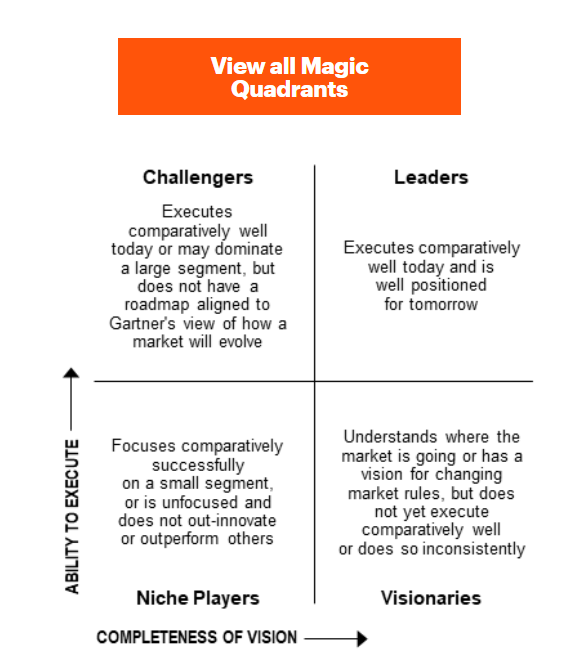When it comes to creating your customer experience strategy, and deciding which partner to execute that strategy with, it is always important to look at third-party research. That is where InMoment believes that evaluative Analyst reports like the Gartner® Magic Quadrant™ can come in.
What is the Gartner Magic Quadrant?
Gartner defines this report as: “A Gartner Magic Quadrant is a culmination of research in a specific market, giving you a wide-angle view of the relative positions of the market’s competitors.”* Based on InMoment’s experience, the Gartner Magic Quadrant is a research methodology and visualization tool that can provide a graphical representation of a market’s direction, maturity, and participants developed by the research and advisory firm Gartner, Inc. The Magic Quadrant evaluates technology providers in a specific market based on their ability to execute and their completeness of vision.
How does a Gartner Magic Quadrant work?
“A Magic Quadrant provides a graphical competitive positioning of four types of technology providers, in markets where growth is high and provider differentiation is distinct. Use a Gartner Magic Quadrant as a first step to understanding the technology providers you might consider for a specific investment opportunity.”*
The Magic Quadrant employs a distinctive methodology to assess and categorize technology vendors within a specific market segment. This categorization involves placing these vendors into one of four quadrants on a two-dimensional graph, a representation that serves as a visual aid for understanding their relative positions in the market landscape. The placement is determined by evaluating the vendor’s “Ability to Execute” and their “Completeness of Vision.”

The vertical axis typically represents the vendor’s ability to execute, encompassing evaluation criteria such as product or service, sales execution/pricing, and overall viability. On the horizontal axis, the completeness of vision is assessed, considering a vendor’s sales strategy, vertical/industry strategy, innovation, and market understanding. The resulting quadrants are labeled as:
- Leaders: Leaders execute well against their current vision and are well positioned for tomorrow.
- Challengers: Challengers execute well today or may dominate a large segment, but do not demonstrate an understanding of market direction.
- Visionaries: Visionaries understand where the market is going or have a vision for changing market rules, but do not yet execute well.
- Niche Players: Niche Players focus successfully on a small segment, or are unfocused and do not out-innovate or outperform others.*
How the Gartner Magic Quadrant Can Provide Value
InMoment believes that the Gartner Magic Quadrant serves a multifaceted purpose that can benefit both technology buyers and providers. For buyers, it acts as an evaluation tool that offers a visual representation of how different technology providers compare within a specific market which can aid in informed decision-making. Moreover, the Magic Quadrant provides a market description and overview helping organizations understand the broader dynamics of a market for strategic planning.
For technology providers, the Magic Quadrant offers insights into competitive positioning which can guide strategic planning and marketing efforts. Overall, the Magic Quadrant enhances market transparency, providing an objective framework for evaluating vendors in complex and evolving technology landscapes, empowering organizations to make well-informed decisions.
Do We Think the Gartner Magic Quadrant is Reliable?
For customer experience professionals, InMoment recommends reading the Gartner Magic Quadrant within specific industry trends and considerations. As a snapshot of the market at a given moment, it can provide valuable insights into technology vendors’ positions based on execution ability and vision completeness.
However, InMoment cautions users to be mindful of the dynamic nature of markets as vendor evaluation can change due to various factors. The subjectivity inherent in the evaluation process, based on analyst judgment, adds another element of interpretation. We think it’s crucial for users to comprehend the methodology and criteria used in each Magic Quadrant and recognize the limited scope of the assessment, which may not capture all relevant aspects for every organization.
While the Magic Quadrant serves as a useful reference point, it should be complemented with ongoing research, customer references, and a broader set of data points for a comprehensive decision-making process. Users should view it as part of a larger toolkit rather than a singular determinant in their technology procurement strategy.
How InMoment Recommends Leveraging the Magic Quadrant in Your Evaluation Process
In our opinion, the Gartner Magic Quadrant can be a valuable resource for buyers navigating the complex landscape of technology solutions. Incorporating the Magic Quadrant into your evaluation process can be particularly beneficial during key stages of vendor selection. Here are instances when we believe referencing the Magic Quadrant can provide valuable insights:
Market Landscape Understanding
We know that in early stages of vendor selection processes, the Magic Quadrant offers a concise overview of the market landscape. It helps you identify some of the players in the market, their positions, and the overall maturity of the market. We think this foundational understanding can inform your initial considerations and narrow down the list of potential vendors.
Shortlisting Potential Vendors
Once you have a list of potential vendors, we feel the Magic Quadrant can become a powerful tool for narrowing down choices. By assessing vendors based on their Ability to Execute and Completeness of vision, you can identify those that align closely with your organization’s needs and objectives.
Understanding Vendor Strengths and Weaknesses
Dive into the details of the Magic Quadrant when you need a more granular understanding of a vendor’s strengths and weaknesses. “Completeness of Vision reflects the vendor’s innovation, whether the vendor drives or follows the market, and if the vendor’s view of how the market will develop matches Gartner’s perspective. Ability to Execute summarizes factors such as the vendor’s financial viability, market responsiveness, product development, sales channels, and customer base.”** These insights aid in a comprehensive evaluation.
Risk Mitigation
As you move closer to the final stages of your decision-making process, we think organizations and procurement departments can use the Magic Quadrant to mitigate risks by assessing vendors’ positions in terms of Ability to Execute and Completeness of Vision.
Remember, while the Magic Quadrant is a valuable tool, it should not be the sole factor in your decision-making process. InMoment strongly recommends combining this with other research, customer references, and a thorough understanding of your organization’s specific requirements for a comprehensive and well-informed vendor selection.
InMoment’s Recommendations for Utilizing Your Takeaways from the Gartner Magic Quadrant in Vendor Discussions
Engaging in discussions with technology vendors can be a nuanced process. Here’s how InMoment suggests organizations leverage your Magic Quadrant learnings effectively in conversations with vendors:
Set Expectations Clearly
Share with vendors the specific criteria that are significant for your organization. This might include factors such as product or service, market responsiveness/record, and alignment with your strategic objectives. We recommend CX professionals use the Magic Quadrant as a reference point to clarify the importance of these criteria in your decision-making process.
Seek Vendor Perspective
If you’re engaging with vendors who are featured in the report, you should encourage those vendors to share their perspectives on their placement in the Magic Quadrant. This can provide valuable insights into their self-awareness, strategic vision, and plans for improvement. Ask about their roadmap and how they plan to enhance both their ability to execute and completeness of vision.
Explore Future Innovations
Discuss a vendor’s future vision and innovation roadmap. Understand how they perceive market trends, and inquire about upcoming features, technologies, or strategies that align with your organization’s long-term goals. This can help you assess the vendor’s potential to stay ahead in a dynamic market.
Build a Collaborative Relationship
Approach vendor discussions with a collaborative mindset. Use Analyst reports like the IDC MarketScape, Forrester Wave, or Gartner Magic Quadrant as shared reference points to collaboratively identify areas for improvement and opportunities for mutual growth. A transparent and constructive dialogue can contribute to building a strong, long-term partnership.
By integrating your Gartner Magic Quadrant takeaways into your vendor discussions, you empower your organization to make well-informed decisions and foster transparent and collaborative relationships with technology providers. Remember to balance the Magic Quadrant insights with a holistic evaluation that considers your unique requirements, user feedback, and the vendor’s responsiveness to your organization’s needs.
How We Think Gartner’s Magic Quadrant Can Help Influence Your CX Strategy
Choosing a CX vendor based on evaluative Analyst reports isn’t solely about improving customer interactions—it’s about crafting a holistic customer experience. By exploring vendors positioned in the research, you not only ensure they meet the criteria for execution and vision, but might also lay the foundation for a comprehensive CX strategy that addresses diverse touchpoints and facets of the customer journey.
We believe the insights from the Garter CX Magic Quadrant will aid you in how to choose a CX vendor. According to us, it helps in finding not only a technological fit for but also a strategic partner. It empowers organizations to make decisions that resonate with their unique objectives and ensures that the chosen CX vendor is not only a technological fit but a strategic partner in achieving comprehensive success.
References
* Gartner, https://www.gartner.com/en/research/methodologies/magic-quadrants-research, as of January 22,2024. GARTNER is a registered trademark and service mark of Gartner, Inc. and/or its affiliates in the U.S. and internationally and is used herein with permission. All rights reserved
**Gartner, How Markets and Vendors Are Evaluated in Gartner Magic Quadrants 10 October 2022



